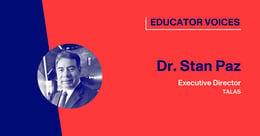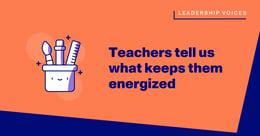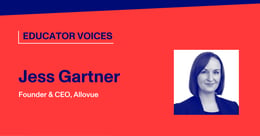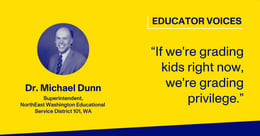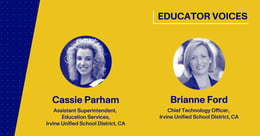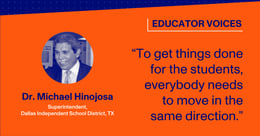This interview, edited for clarity and length, is part of a series with educational leaders to highlight their perspectives on the changing realities of education.

Building a better tomorrow in the Bluegrass State
5 Questions with Chaka Cummings
Since 1983, the Prichard Committee has worked to study priority issues, inform the public and policymakers about best practices and mobilize citizens, business leaders, families, students, and other stakeholders in a shared mission to move Kentucky to the top tier of all states for education excellence and equity for all children.
The Paper™ team recently had the pleasure of speaking with Chaka Cummings, Manager of K-12 and Equity Policy, who's had a long career in education as an educator, school administrator, and coach. Mr. Cummings gave the team an overview of the Prichard Committee's priorities, how Kentucky educational leaders are tackling equity gaps, and how an equitable solution like Paper can benefit the community.
Tell us about the Prichard Committee and what you are doing to fight equity gaps within the Kentucky education system.
The Prichard Committee, at its core, is an educational advocacy group. We're involved in several support pillars across the board, one of which is citizen advocacy. What that means is, we try to get as many people in Kentucky as possible to fight for the best possible educational outcomes for students in public education. We do that through different methodologies:
- We have our groundswell, which is our way of engaging and mobilizing our citizen advocates.
- We have our programs around parent engagement, where we provide the framework for how parents can get involved in advocating for their children at the local levels.
- We also have our equity coalition, which I lead.
In that endeavor, we specifically discuss equity-based initiatives around education in the state of Kentucky.
Can you share some of the biggest equity challenges you're seeing educational leaders face right now?
One big challenge we're seeing is something called the achievement gap. We can map out student performance and achievement demographically across Kentucky, and we can see where performance is different for people based on various demographics. So, for example, we can look at historically underserved populations, like our Black or brown students, and see a trend of performance disparity based on the data we've collected.
Not only that, but we are also seeing an issue with broadband access. When we start talking about non-traditional instruction and students going remote, not every student has equal access to the devices and internet services they need to learn and work remotely. Just looking at Kentucky, there are several areas where people live in more rural communities where they don't have a population density that would incentivize a company to put enough broadband wires in the ground to provide everyone with sufficient access. Urban cities, like Lexington or Louisville, don't face those issues as much due to high demand.
What types of tactics or solutions are educators considering for these types of challenges?
We are working to solve the racial inequity aspect of the achievement gap by hiring more Black teachers. Right now, in Kentucky, 10% of the students identify as Black. Our teaching population, however, has less than 5% who identify as Black. We see similar inequities for our LatinX and Asian students. By hiring more teachers that look like the representative population of students with whom they can identify, you're able to bridge that gap.
When tackling the broadband access issue, we have to consider two things: affordability and location. For the first, we can look at broadband co-ops to help alleviate the cost of broadband access. For the second, we know that the governor has reached out to the broadband companies and is working with them on solutions for getting stronger access within those rural communities. We believe it's important to stay informed on these decisions.
One of our Groundswell members put forth a plan in Eastern Kentucky around tutoring services and exploring how to make sure we can get those services to students. If we can utilize the funding from the American Rescue Plan, we can look at using it to financially support extended school services and ensure that we're taking advantage of those dollars. Unfortunately, those dollars wouldn't be a permanent boost to the education economy. Therefore, it's crucial that we take advantage and use them to start solving current and potential extended school services issues that might arise. We see several solutions to these challenges. As long as people are thinking intelligently about how to attack and utilize the strategies that we know to advance the solutions, we should be in a good place.
In what ways do you think a program like Paper could benefit your community?
We know that each student has unique responsibilities and challenges in and out of school. There are students who work, play sports, and have parents who can't help them with homework; the list goes on. To have a product or a tool that's flexible and can meet them where they are and when they need it is an obvious benefit to our students. Furthermore, when we think about recovery from COVID, we know that many students are going to be at different levels. Therefore, in order to meet students where they are, we're going to need a plethora of services. In other words, an increase in need will demand an increase in support. I can see that Paper is that type of product. It is flexible and robust enough to support any student in any situation.
One thing I love about Paper is its use of the Paper Method. Students are not just going to get the answer but rather are taught to talk through the problem, so they are really thinking it through and, hopefully, internalizing the process. Paper doesn't just give students the information to digest and regurgitate; it facilitates deep learning and understanding that will go beyond solving one homework problem.
Can you share a takeaway from this past year and what initiatives you have seen or believe will help create the future of education?
One takeaway coming out of this past year is that if you were a student in a transition year in non-traditional instruction, it probably feels like you've been double-dated. What I mean by that is this: imagine that you were going into kindergarten in 2019, you went remote the second half of your school year, and then you spent your first-grade year remote as well. You are now going into second grade. You have not learned how to behave in a traditional instruction setting, like walking in a line, raising your hand, or grabbing the pass and going to the bathroom. Students in this situation have to make up for those pieces as well as navigate this new world that is the COVID world of the 2020-21 school year.
This unique situation also applies to students going from elementary school to middle school. They are going from very concrete thinking to trying to understand more abstract concepts and doing it with ten different teachers in some instances. That's a challenge. Furthermore, students going from middle school to high school will probably not be as prepared as their peers from previous years because their experience was such that they didn't get the content their peers had gotten. That's another challenge.
So how do we address these types of challenges? Frankly, I believe that extended school services play a big part. Organizations like Paper support advancing solutions in this very challenging field space. It will be very difficult for any one teacher to make up for that kindergartner who does not have to have a "lived memory" of school experience in second grade. One teacher is not going to be able to do that. That's where Paper comes into the mix. While there is this unique challenge, there's also an opportunity. And it's going to be partners in the extended school services space who will help advance strategies around set opportunities.

